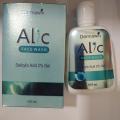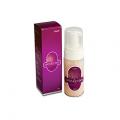Home / Categories / ACNACE 100ML

ACNACE 100ML
SALICYLIC ACID 2%W/W
KERATOLYTIC AGENT
QUEST LIFESTYLE P. LTD.
Product Details
| Salicylate Combination |
| (suh-LIS-ih-late) |
| Choline Magnesium Trisalicylate, Tricosal, Trisilate |
| Class: Analgesic/salicylate combination |
 Action Relieves pain by inhibiting prostaglandin synthesis and release; reduces fever by vasodilation of peripheral vessels. Unlike aspirin, does not inhibit platelet aggregation.
Action Relieves pain by inhibiting prostaglandin synthesis and release; reduces fever by vasodilation of peripheral vessels. Unlike aspirin, does not inhibit platelet aggregation.
 Indications Relief of mild to moderate pain; treatment of rheumatic fever and rheumatoid arthritis including juvenile arthritis and osteoarthritis; management of fever.
Indications Relief of mild to moderate pain; treatment of rheumatic fever and rheumatoid arthritis including juvenile arthritis and osteoarthritis; management of fever.
 Contraindications Hypersensitivity to nonacetylated salicylates, NSAIDs or aspirin; advanced chronic renal insufficiency; bleeding disorders; GI bleeding.
Contraindications Hypersensitivity to nonacetylated salicylates, NSAIDs or aspirin; advanced chronic renal insufficiency; bleeding disorders; GI bleeding.
Inflammatory Conditions
ADULTS: PO 1500 mg bid or 3000 mg qd. ELDERLY PATIENTS: PO 750 mg tid.
Fever, Mild to Moderate Pain
ADULTS: PO 1000 to 1500 mg bid. CHILDREN < 37 KG: PO 50 mg/kg/day in 2 divided doses. CHILDREN > 37 KG: PO 2250 mg/day in 2 divided doses. Doses are adjusted based on patient's response, tolerance and serum salicylate concentration.
Carbonic anhydrase inhibitors (eg, acetazolamide): Accumulation of carbonic anhydrase inhibitor and toxicity. Corticosteroids: Decreased plasma salicylate concentration. Methotrexate: Could cause methotrexate toxicity. Oral hypoglycemics or insulin: Could cause hypoglycemia. Urinary acidifiers: Increased salicylate serum concentration. Urinary alkalinizers (eg, chronic antacids): Decreased salicylate serum concentration. Warfarin: Enhanced anticoagulant activity of oral anticoagulants. Creates potential for increased prothrombin time due to protein-binding displacement.
 Lab Test Interferences Phenolsulfonphthalein: Salicylates decrease renal excretion. Thyroid function tests: Drug causes increased free T4 and decreased total T4; thyroid function is not affected. Urine glucose: Drug causes false-negative results by glucose oxidase method and false-positive results by copper reduction method with moderate to high doses of salicylates. Urine 5-HIAA: Salicylates interfere with fluorescent method. Urine ketones: Drug causes interference with ferric chloride (Gerhardt) method by turning urine a reddish color. Urine vanillylmandelic acid: Salicylates can interfere with determination.
Lab Test Interferences Phenolsulfonphthalein: Salicylates decrease renal excretion. Thyroid function tests: Drug causes increased free T4 and decreased total T4; thyroid function is not affected. Urine glucose: Drug causes false-negative results by glucose oxidase method and false-positive results by copper reduction method with moderate to high doses of salicylates. Urine 5-HIAA: Salicylates interfere with fluorescent method. Urine ketones: Drug causes interference with ferric chloride (Gerhardt) method by turning urine a reddish color. Urine vanillylmandelic acid: Salicylates can interfere with determination.
DERM: Hives; rash; angioedema. EENT: Tinnitus. GI: Nausea; dyspepsia; gastric ulceration. HEMA: Prolonged bleeding time. HEPA: Hepatotoxicity. META: Uric acid levels elevated by salicylate concentrations < 10 mg/dl and decreased by levels > 10 mg/dl. RESP: Bronchospasm. OTHER: Anaphylaxis; salicylism may occur with large doses or chronic therapy (symptoms include dizziness, tinnitus, vomiting, diarrhea, confusion, CNS depression, headache, sweating, hyperventilation and lassitude); fever.
Pregnancy: Category C. Do not use during third trimester; could prematurely close ductus arteriosus in the fetus. Lactation: Excreted in breast milk. Children: May increase risk of Reye's syndrome; do not use in individuals < 18 yr if chickenpox or flu symptoms are suspected. Special risk patients: Use drug with caution in patients with renal or hepatic dysfunction, peptic ulcer disease or gastritis. Aspirin or NSAID hypersensitivity: Nonacetylated salicylates have been tolerated in aspirin-sensitive asthmatic patients; however, cases of cross-sensitivity including bronchospasm have been reported.
| PATIENT CARE CONSIDERATIONS |
|
- May cause GI upset; take with food or after meals. Take with a full glass of water.
- Store in tight, light-resistant container.
- Obtain patient history, including drug history and any known allergies.
- Assess quality of pain (location, onset, type and duration) or temperature prior to therapy.
- Monitor pain relief and temperature after medication administration.
- Inspect affect joints. Assess mobility, swelling/deformities and skin condition.
- Monitor improvement during therapy (fever reduction, relief from joint tenderness and pain; increased movement).
- Assess areas of bruising prior to and during therapy. Report increased bruising immediately to physician.
- If tinnitus, flushing, tachycardia, hyperventilation, sweating or thirst occurs, withhold medication and immediately notify physician.
- Obtain baseline hepatic and renal studies and CBC, PT and PTT. Monitor periodically if patient is undergoing long-term therapy.
- Monitor salicylate serum levels as ordered by physician.
|
||||
- Advise patient to take medication with food or after meals with full glass of water.
- Emphasize need to avoid alcohol ingestion and use of NSAIDs during therapy (which increase risk of GI irritation/GI bleeding), especially if patient is undergoing long-term therapy.
- Instruct patients with diabetes to monitor blood levels closely during treatment.
- Instruct patient to call physician immediately if ringing in ears or persistent GI pain occurs while taking this medication.
Books@Ovid
Copyright © 2003 Facts and Comparisons
David S. Tatro
A to Z Drug Facts
 Route/Dosage
Route/Dosage Interactions
Interactions Adverse Reactions
Adverse Reactions Precautions
Precautions Administration/Storage
Administration/Storage Assessment/Interventions
Assessment/Interventions Patient/Family Education
Patient/Family Education
